by Derek Teed
June 2019
Industries in the Computer and Electronic Product Manufacturing subsector group have establishments that manufacture computers, computer peripherals, communications equipment, and similar electronic products, and establishments that manufacture components for such products.1 The Computer and Electronic Product Manufacturing industries have been combined in the hierarchy of NAICS because of the economic significance they have attained. Table 1 shows the six subsectors with the corresponding number of firms, jobs, and their annual wages.
Wages: While manufacturing wages in Minnesota have been rising over the last two decades the wages in Computer and Electronic Product Manufacturing have been rising faster. Manufacturing wages grew from $41,548 in 2000 to $67,080 in 2018. In Computer and Electronic Products wages rose from $54,704 in 2000 to $99,476 in 2018.
Employment: Employment in Computer and Electronic Product Manufacturing (334) shrank from 65,528 jobs in 2000 to 45,382 jobs in 2018. From 2000 to 2018 the only 4-digit subsectors that grew in employment was Navigational, Measuring, Electromedical, and Control Instruments Manufacturing (3345). All other 4-digit subsectors shrank employment from 2000 to 2018 (see Figure 1).2
| Manufacturing Jobs in Minnesota | |||
|---|---|---|---|
| Industry | Number
of Firms |
Number
of Jobs |
Average
Annual Wage |
| All Manufacturing | 8,477 | 321,836 | $67,080 |
| Computer and Electronic Product Manufacturing (334) | 525 | 45,382 | $99,476 |
| Computer and Peripheral Equipment Manufacturing (3341) | 75 | 7,339 | $113,984 |
| Communications Equipment Manufacturing (3342) | 42 | 1,367 | $84,552 |
| Audio and Video Equipment Manufacturing (3343) | 22 | 169 | $52,728 |
| Semiconductor and Other Electronic Component Manufacturing (3344) | 153 | 9,588 | $68,692 |
| Navigational, Measuring, Electromedical, and Control Instruments Manufacturing (3345) | 217 | 26,645 | $107,848 |
| Manufacturing and Reproducing Magnetic and Optical Media (3346) | 16 | 273 | $78,104 |
| Source: DEED Quarterly Census of Employment and Wages (QCEW) | |||
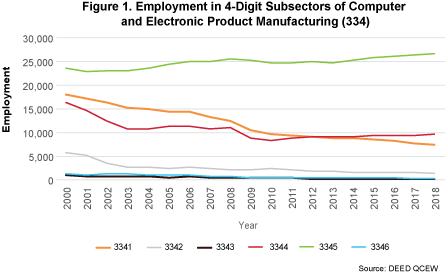
1Classification Development Branch. (2010, November 02). US Census Bureau Site North American Industry Classification System main page. Retrieved July 31, 2019.
2Quarterly Census of Employment and Wages (QCEW). (n.d.). Retrieved August 8, 2019, from Quarterly Census of Employment and Wages Areas
The Construction of Buildings subsector comprises establishments primarily responsible for the construction of buildings. The work performed may include new work, additions, alterations, or maintenance and repairs. The on-site assembly of precut, panelized, and prefabricated buildings and construction of temporary buildings are included in this subsector.1 Establishments in the subsectors in Table 1 are classified based on the types of buildings they construct. These classifications reflect variations in the requirements of the underlying production processes.
Wages: Figure 12 shows that wages for the Construction of Buildings industry rose over the last two decades but were mired in a cyclical dip from 2007 until about 2011 when they started rising again. This dip was mostly caused by a steep drop in business for the Residential Building Construction industry during the real estate crash.
Employment: Figure 23 demonstrates that Construction can be a cyclical industry. The real estate crash from 2005 to 2010 can be seen in Figure 2. The recession significantly shrank employment in the Construction of Buildings industry by 30% from 31,279 in 2005 to 20,334 in 2010. Most of this fall was from the Residential Building Construction industry's falling from 17,644 in 2005 to 9,151 in 2010. Employment in the subsector has slowly recovered since 2010 as low interest rates set by the Federal Reserve have created higher demand for home ownership and Residential Construction.
| Construction of Buildings, 2018 | |||
|---|---|---|---|
| Industry | Number of Firms | Number of Jobs | Average Annual Wage |
| All Construction | 16,651 | 128,769 | $67,028 |
| Construction of Buildings (236) | 4,602 | 27,230 | $69,784 |
| Residential Building Construction (23611) | 3,541 | 12,406 | $52,676 |
| Industrial Building Construction (23621) | 131 | 1,715 | $91,572 |
| Commercial and Institutional Building Construction (23622) | 930 | 13,108 | $83,044 |
| Source: DEED Quarterly Census of Employment and Wages (QCEW) | |||
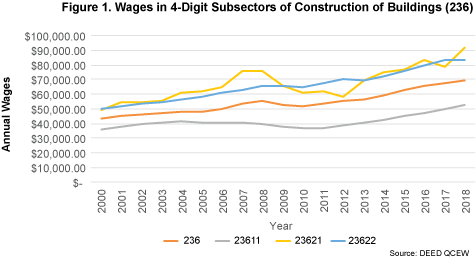
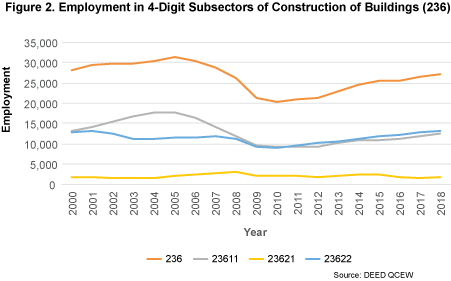
1Classification Development Branch. (2010, November 02). US Census Bureau Site North American Industry Classification System main page. Retrieved August 2, 2019.
2Quarterly Census of Employment and Wages (QCEW). (n.d.). Retrieved August 8, 2019, from Quarterly Census of Employment and Wages Areas
3Ibid.
Industries in the Couriers and Messengers subsector provide intercity, local, and/or international delivery of parcels and documents (including express delivery services) without operating under a universal service obligation. Most of the transportation activities are by vehicle these days. In the past it was by bicycle. The restriction to small parcels partly distinguishes these establishments from those in the transportation industries. The complete network of courier services establishments also distinguishes these transportation services from local messenger and delivery establishments in this subsector. Messengers, who usually deliver within a metropolitan or single urban area, may use bicycle, foot, small truck, or van.1
Wages: Figure 1.2Wages for Couriers and Messengers have been lower than the Minnesota average wages since 2000 but the wages have steadily increased since 2000. Annual wages in Couriers and Messengers was $45,656 in 2018 while the average wage in Minnesota wage was $58,032. The steep rise in wages for the Local Messengers and Local Delivery (4922) from $39,624 in 2016 to $49,088 highlights an increased demand for this services which could make this industry support higher than average wages in the coming years.
Employment: Employment in Couriers and Messengers had been slowly falling from 10,985 in 2000 to 9,611 in 2012. Afterwards, the increase in online shopping has led to a steady increase in employment since 2012, and employment increased to 12,997 by 2018. As the increase in online shopping and deliveries continue to rise we can expect employment to increase in this industry for the foreseeable future (see Figure 23).
| Couriers and Messengers, 2018 | |||
|---|---|---|---|
| Industry | Number of Firms | Number of Jobs | Average Annual Wage |
| Trade, Transportation, and Utilities | 38,160 | 551,590 | $49,972.00 |
| Couriers and Messengers (492) | 284 | 12,997 | $45,656.00 |
| Couriers (4921) | 187 | 10,719 | $44,928.00 |
| Local Messengers and Local Delivery (4922) | 97 | 2,278 | $49,088.00 |
| Source: DEED Quarterly Census of Employment and Wages (QCEW) | |||
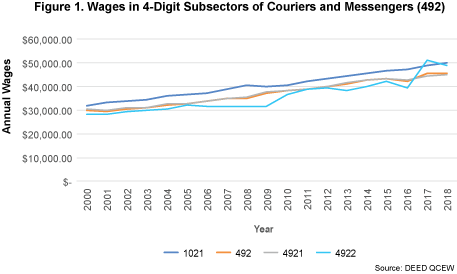
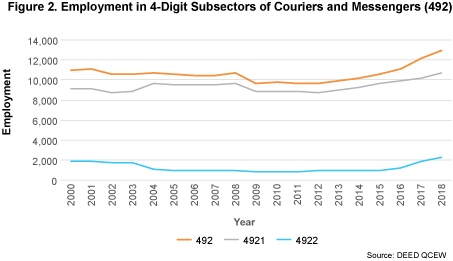
1Classification Development Branch. (2010, November 02). US Census Bureau Site North American Industry Classification System main page. Retrieved July 31, 2019.
2Quarterly Census of Employment and Wages (QCEW). (n.d.). Retrieved August 8, 2019, from Quarterly Census of Employment and Wages Areas
3Ibid.
Industries in the Credit Intermediation and Related Activities subsector group establishments that (1) lend funds raised from depositors; (2) lend funds raised from credit market borrowing; or (3) facilitate the lending of funds or issuance of credit by engaging in such activities as mortgage and loan brokerage, clearinghouse and reserve services, and check cashing services.1The majority of the employment in this subsector is in Commercial Banking (52211). Intermediation is Fed Speak for any sort of lender, usually a bank, that matches people who want to borrow money with people willing to lend.
Wages: Annual wages have steadily increased for Credit Intermediation and related since 2000. The wages have stayed significantly above the average Minnesota wage. The only significant dip in wages came in the Non-depository Credit Intermediation industry from $69,004 in 2003 to $63,284 in 2006, which was likely from a steep drop in employment in Real Estate Credit (NAICS 522292) (see Figure 12).
Employment: Employment in Credit Intermediation and Related has been rising since 2000 but dipped after the housing slowdown and financial crisis from 2006 to 2010. The employment dip was largely caused by the Real Estate Credit industry's falling from 9,219 in 2003, to 3,831 in 2009 and 3,913 in 2018 (see Figure 23).
Since 2014 the Depository Credit Intermediation industry has risen significantly from 43,105 jobs to 51,933 jobs in 2018 in Minnesota. This increase in employment correlates with the increase in the Federal Funds interest rate from about .12% in 2015 to about 2.2% in December 2018.
| Credit Intermediation and Related | |||
|---|---|---|---|
| Industry | Number of Firms | Number of Jobs | Average Annual Wage |
| Financial Activities | 15,883 | 179,381 | $95,576 |
| Credit Intermediation and Related Activities (522) | 2,831 | 63,743 | $87,984 |
| Depository Credit Intermediation (5221) | 1,905 | 51,933 | $86,528 |
| Non-depository Credit Intermediation (5222) | 546 | 8,284 | $91,312 |
| Activities Related to Credit Intermediation (5223) | 380 | 3,525 | $102,232 |
| Source: DEED Quarterly Census of Employment and Wages (QCEW) | |||
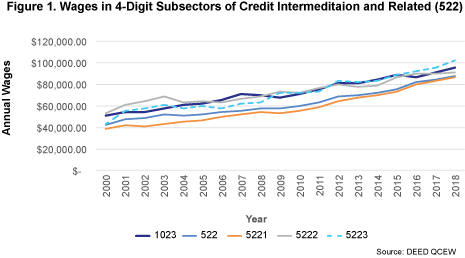
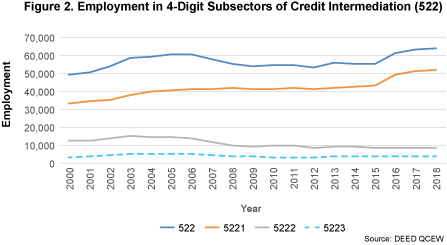
1Classification Development Branch. (2010, November 02). US Census Bureau Site North American Industry Classification System main page. Retrieved July 31, 2019
2Quarterly Census of Employment and Wages (QCEW). (n.d.). Retrieved August 8, 2019, from Quarterly Census of Employment and Wages Areas
3Ibid.